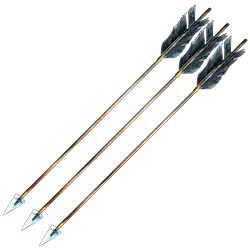Medieval Arrows
A bow was only as good as the arrows a person had to use. A person from the medieval age would use different arrows depending on what he was doing and on what type of bow the person was using. There were regular (or short) bows, long bows, and crossbows. Each type of bow required a different arrow.
Also, different arrows were used depending on what the person was doing. A person used a different arrow for hunting than for war and even used different arrows for different opponents in war.

Arrows have a straight shaft with an arrowhead on one end and feathers on the other end. Typically, each arrow would have three feathers around the shaft of the arrow. The feathers were used to help the arrow fly straight so that it wouldn’t be affected by air or by the spin of the arrow. The feathers (called fletching) were different sizes depending on the size of the arrow. A heavy arrow needed larger fletching than a lighter arrow. You couldn’t put fletching that was too large on the arrow because that would increase the drag on the arrow. Drag is what slows the arrow down as it passes through the air.
The feathers used for fletching each arrow would come from the same bird, and in fact, from the same wing. Bird feathers on a wing all curve in the same direction but the left wing feathers curve in the opposite direction of the right wing feathers. By using the feathers from the same wing, the feathers would all curve the same way. This would help ensure that the arrows would spin smoothly as it left the bow which in turn would help ensure accuracy.
The arrows would typically be carried in a canvas bag. The bag would cover the whole arrow and the bag was typically tied to the archer’s waist or to the archer’s back. By having the whole arrow covered in the bag, the arrows wouldn’t fall out and were protected from the rain.

Short Bow and Longbow Arrows
Arrows used for short bows and longbows ranged between 70 to 90 centimetres in length. The length of the arrow depended on the size of the bow being used. The diameter of the arrow shaft was around one centimeter.

Crossbow Arrows
A crossbow arrow is called a bolt or a quarrel. It is typically around twenty-two centimetres to thirty-eight centimetres long. Crossbow bolts were also used for hunting although they were usually given a dull point and even poisoned so that the hunted animal would be stunned instead of killed.

Arrowheads
Arrowheads changed as the bow became used for different things. In the beginning of the Middle Ages, the arrowheads used in battle were exactly the same as the arrows used in hunting. They were flat, made of metal and approximately five to seven centimeters long. The arrowheads were about five centimeters wide and had a barb on both sides. These arrowheads were called broadhead arrows. These arrows would be able to cut through cloth or an animal’s skin. The barbs would make it difficult to remove the arrow which would help disable the person or animal being shot. These types of arrowheads were used throughout the Middle Ages, even in war, although they were not strong enough to pierce mail or plate armor. Even though most of the time these arrows would just bounce off the well-protected knights, they were still useful in attacking war horses or attacking soldiers wearing lighter armor.
As the armor worn by knights and other soldiers became stronger, new arrowheads were developed to combat this stronger armor. These new arrowheads were called bodkins. The new arrowhead got rid of the barbs and became longer and narrower. The narrow arrowhead had a better chance of being able to penetrate medieval ring mail and plate mail. Long bodkin points were about seven centimetres long and some were even longer. Long bodkin points were designed to fight soldiers wearing ring mail. The arrow point would pass through the rings and injure the soldier.
Short bodkin points were designed to pierce plate armor. Short bodkin points were around five centimetres long and were not as narrow. Some short bodkin arrowheads would be in a four-sided pyramid shape with a sharp point at one end. This shape gave the arrowhead more strength to punch through the plate mail. Even when the arrows were unable to pierce an opponent’s armour, the speed with which the arrow travelled would still result in an opponent being injured. Arrows could break bones as even give a person wearing plate mail a concussion. Arrows with these new bodkin points when used with a longbow could travel around 250 meters.
Arrowheads were made out of iron or steel and the feathers were typically goose feathers. The arrow shaft was made from various types of wood.
The arrow used was just as important as the bow. The archer needed to know the conditions and the opponents he faced so he could choose the arrow that was most appropriate for the situation.




